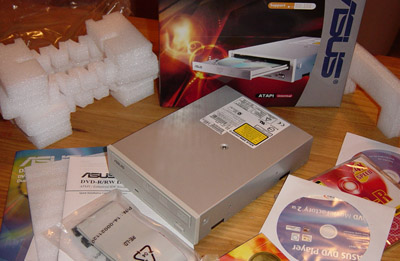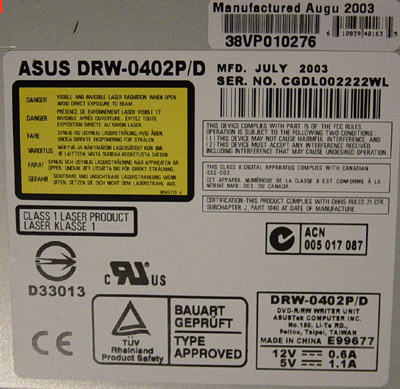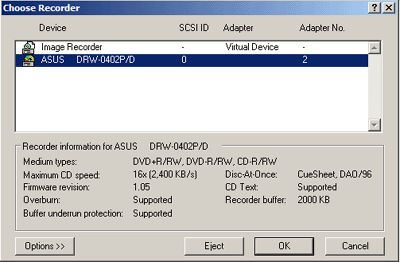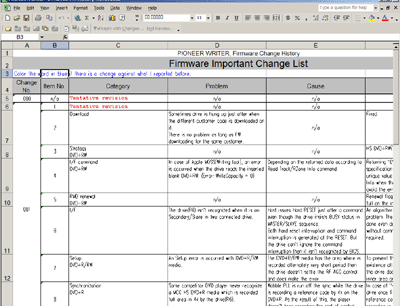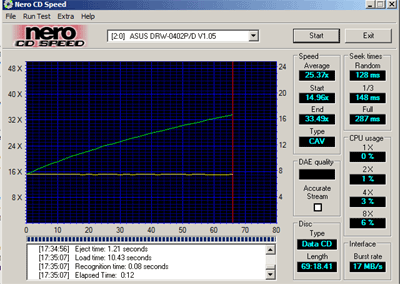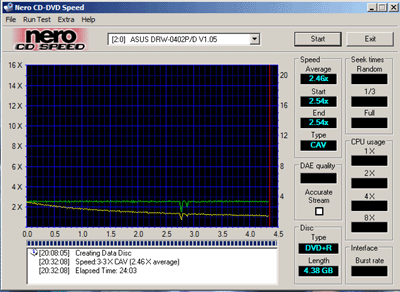
Original Link: https://www.anandtech.com/show/1159
ASUS DRW-0402P/D: ASUS joins the dual format fray
by Kristopher Kubicki on September 21, 2003 6:13 PM EST- Posted in
- Storage
When dealing with computers, an entire industry can change in less than a year. It was just less than a year ago that virtually all DVDR drives were only capable of writing to one format at 1X and 2X speeds. Nine months after the 4X DVD-/+R standards were finalized, we started seeing some 8X DVD-R drive sampling from Plextor. Companies like Sony, NEC, ASUS, Pioneer Mitsumi, BTC, and Gigabyte all debuted multiple format drives as well; not to mention that each drive costing half as much as they did 18 months ago. It would seem that the DVDR product wars are starting to show some actual progress for the consumer.
Most importantly, the so called “format wars” that were to destroy the market failed to manifest themselves. A year ago, manufacturers were pretty split on which format was going to control the DVDR market. However, with as many dual format drives in the market today, it’s almost easy to dismiss either format from becoming “standard.” In all honesty, it is probably cheaper for manufacturers to just pay both royalty fees to the DVDR forums rather than produce two separate drives.
Enter ASUS. ASUS has been a fairly large player in the optical market in the past, but just stepped into the DVDR market with a single format DRW-0402P (DVD-R). The drive itself received mixed product reviews, mostly due to competitive drives supporting multiple formats. Without further delay, let us take a look at ASUS’ second DVDR product, the multi-format DRW-0402PP/D.
Construction
The drive shipped with an average amount of media, one 52X CDR, and a 4X DVD-R. We thought the 52X CDR was a little unusual since the drive is only capable of 16X CD writes. Cables, manuals and the drive were all present too, of course.Click to enlarge.
For bundled software, ASUS went with a Sonic suite (bundled with Sonic DLA 4 and RecordNow DX 4.6). While Sonic is a good recording suite, we were a little surprised that ASUS did not bundle Ahead’s Nero with the drive (which they have bundled in any other optical drive that we have seen). As always, the bundled Quick Install and Manual documentation were excellent. Both guides were very easy to read and perhaps some of the more organized documents that we have seen in a while. Unfortunately, online documentation at time of publishing was scarce.
Click to enlarge.
Click to enlarge.
The DRW-0402P/D is as pleasing on the eye. Compared to ASUS’ other optical storage, the drive is actually quite Spartan. A sole LED denotes read and write, while the sole button on the drive only allows for eject. There are two ventilation slits on the front of the drive for intake. A separate fan on the rear of the unit is for exhaust.
Click to enlarge.
Specifications
Below is a quick overview of specifications on the drive:| ASUS DRW-0402P/D DVD-/+R Drive | |
| Interface | IDE |
| CD Write Speed | 16X, 12X, 8X, 4X (CLV) |
| CD Rewrite Speed | 10X, 4X (CLV) |
| CD Read Speed | 32X Max (4,800KB/s) (CAV) |
| DVD-R Write Speed | 4X, 2X, 1X (CLV) |
| DVD-RW Rewrite Speed | 2X, 1X (CLV) |
| DVD+R Write Speed | 4X, 2.4X (CLV) |
| DVD+RW Rewrite Speed | 2.4X (CLV) |
| DVD Read Speed | 16X Max (16,620KB/s) (CAV) |
| Supported Modes | DAO / DAO-RAW 16 & 96 TAO SAO / SAO 16 & 96 Packet Write Multi-Session |
| Supported Formats | DVD+R (incremental) DVD+RW (random) DVD-R (DAO, incremental, multi-border) DVD-RW (restricted overwrite) CD-R, CD-RW, CD-ROM, CD-DA, CD-ROM XA, Mixed Mode, CD Extra Photo CD, CD Text, Bootable CD, Mount Rainer |
| Access Time | CD: 130ms DVD: 140ms |
| Buffer | 2000 KB |
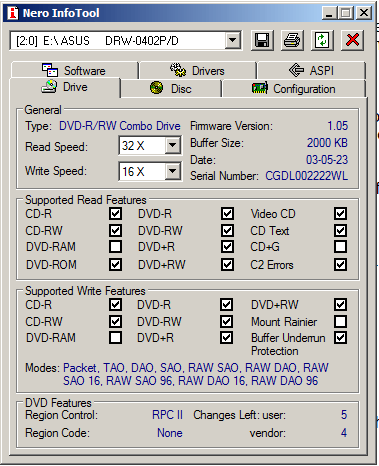
Notice the absence of Mount Rainier from the supported modes. Even though Mt Rainier is still a developing write mode, UDF should be pursued for its future compatibility.
The specifications on the drive vary compared to what the manual and product website actually advertise. The manual claims the CD rewrite speeds are only 10X and 4X, when in fact, the drive recognized 16X, 12X, 4X and 2X in Nero 5.5. We will talk more about these differences later in the review. For those of you who have Pioneer A06 drives, you will notice that these specifications are identical. It is our knowledge that both drives are most likely manufactured in the same facility.
Click to enlarge.
Our original drive came with firmware version 1.05, which at time of publication was the highest available. Interestingly enough, the ASUS 1.05 firmware download contains a Changelog of firmware upgrades, which states “Pioneer” at the top and mentions firmware revisions running through 1.07. Unfortunately, attempting to download the Pioneer A06 upgrades do not work. Forcing the upgrade is perhaps possible, but probably not a good idea.
Click to view spreadsheet.
Testing the Drive
We used the following configuration to test our DRW-0402P/DGigabyte GA-7VRXUsing CD Speed 2.02 and DVD Speed, we had run a battery of read, write and rewrite tests on the drive. Our first test determines CD read speed in normal mode, while the second determines the speed while the turbo 52X mode is enabled. The following read speeds are for a pressed HP System Recovery CD.
AMD Athlon MP 2100+
2 x 128 DDR Corsair XMS 2400
Maxtor 80GB 7200RPM 8MB Cache
Windows XP SP1
Click to enlarge.
Interestingly, the drive seems more than capable of the advertised 32X max CD read speeds. With only 70 minutes of data, the DRW had no problems obtaining speeds higher than 33X read. Unfortunately, the random seek times are incredibly awful compared to high end CDR drives. Our findings found that full seeks actually took double the amount of time on normal. CD Speed reports 17MB/s burst rates on the DRW while most CDRW drives we’ve looked at were only capable of 1MB/s.
You may have noted that the full seek times are phenomenal on these drives for Pressed DVD Video. Unfortunately, CD Speed reports this particular value erroneously, as most of our DVD-/+RW reads were in excess of 300ms. On DVD media, CD Speed reported the drive bursting over 23MB/s consistently.
We also tested the drive on a variety of DVD+R, DVD-R, DVD+RW, DVD-RW, CDR, CDRW and DAE media. The follow table contains our results.
| Average Transfer | Seek Random | Seek 1/3 | Seek Full | Media Length | |
| Pressed HP System Recovery | 25.37X | 128ms | 148ms | 287ms | 69:18.41 |
| Pressed DAE Global Underground 24 CD2 | 25.31X | N/A | N/A | N/A | 73:20.15 |
| Burned PNY 48X CDR Dummy File | 25.33X | 130ms | 152ms | 295ms | 74:00.05 |
| Burned Mitsubishi 32X CDRW Dummy File | 25.41X | 126ms | 161ms | 293ms | 74:00.05 |
| Pressed DVD The Matrix | 6.13X | 142ms | 241ms | 45ms | 7.82GB |
| Pressed Mixed DVD The Animatrix | 6.29X | 136ms | 237ms | 49ms | 7.92GB |
| Bundled (Generic?) 4X DVD-R Data CD | 4.60X | 136ms | 169ms | 310ms | 4.38GB |
| TDK 4X DVD-R Data CD | 4.66X | 140ms | 171ms | 308ms | 4.38GB |
| FujiFilm 4X DVD+R Data CD | 4.62X | 133ms | 167ms | 315ms | 4.38GB |
| Imation 4X DVD+R Data CD | 4.61X | 136ms | 164ms | 311ms | 4.38GB |
| FujiFilm 4X DVD-RW Data CD | 4.62X | 139ms | 170ms | 316ms | 4.38GB |
| FujiFilm 2.4X DVD+RW Data CD | 4.67X | 138ms | 172ms | 324ms | 4.38GB |
Write Speeds
|
Click to enlarge. CD Speed determining the burn speed of a CDR. |
Below are the CD-R, CD+RW, DVD+R, DVD+RW, DVD-R and DVD-RW speed tests. We used CD Speed with the same configuration as the previous test.
| Average Transfer | Media Length | |
| ASUS 52X CDR Data CD | 15.97X | 79.49.74 |
| PNY 52X CDR Data CD | 15.95X | 79.49.74 |
| Mitsubishi 32X CDRW Data CD | N/A | 73:43.00 |
| Mitsubishi 24X CDRW Data CD | N/A | 73:43.00 |
| FujiFilm 12X CDRW Data CD | 8.33X | 73:43.00 |
| FujiFilm 4X DVD-R Data CD | 4.01X | 4.38GB |
| Bundled (Generic?) 4X DVD-R Data CD | 4.00X | 4.38GB |
| TDK 4X DVD-R Data CD | 4.02X | 4.38GB |
| FujiFilm 4X DVD+R Data CD | 4.01X | 4.38GB |
| Imation 4X DVD+R Data CD | 2.95X | 4.38GB |
| FujiFilm 4X DVD-RW Data CD | 1.95X | 4.38GB |
| FujiFilm 2.4X DVD+RW Data CD | 2.46X | 4.38GB |
Obviously, the ASUS DRW was not capable of burning all of our media at the speeds for which the media was rated. Obviously, some of our 12X CDRW media was bumped down to 10X as the maximum CD rewrite speed. However, the most obvious problem was with the Mitsubishi CDRW media. Typically, we regard this as very high quality CDRW media, but for whatever reason, the A06 completely refused to write or acknowledge the media as rewriteable. Reading from the Mitsubishi disks was no problem.
Another thing that kept us reserved was the unusual write speeds on some media. For example, our 4X rated Imation DVD+R media would only write around 3X, while FujiFilm disks had no problem writing at 4X. Keep in mind that FujiFilm DVD media is not nearly as high caliber as some of the other disks we used in this benchmark. Further tests confirmed that the drive inaccurately would not recognize other 4X DVD-R and DVD+R media from TDK, PNY and Imation. These inconsistencies in media would probably be solved by firmware upgrades. Feel free to check out the DWR 1.05 BIOS revision spreadsheet, DVR106D FW History Rev105.xls. As you can see, this drive has had a history of problems with various media. It would be wise to purchase only media for this drive that is mentioned in the Changelog as working.
Below is a sample write test with FujiFilm 2.4X DVD+RW disks that were recognized as DVD+R by CD Speed. The burner had no problem at 2.46X.
Click to enlarge.
Final Thoughts
The ASUS DRW-0402P/D is certainly an impressive drive. Even though we had compatibility issues with CDRW and DVD+R media, the drive performed reasonably well on DVD+RW and DVD-R/W media. CDR writes were somewhat slow at 16X. However, to be honest, the drive must be aggressively priced with the Pioneer A06 in order to warrant a purchase. The drive is just starting to hit US soil, with online merchants carrying the drive around $250. Obviously, if the identical Pioneer A06 is priced around $230, ASUS will have a difficult time convincing consumers to buy it (even more so, if ASUS cannot keep BIOS updates current with the Pioneer releases).In our opinion, the DRW-0402P/D is certainly worth the purchase (if you can find it for less than the Pioneer A06). Considering where DVDR drives were at last year, the industry has come a long way. On the other hand, with Computex and COMDEX around the corner, we might see some very interesting product announcements in the area of optical storage. Even more interesting, new drives from a few other big name manufacturers might just take the crown from Pioneer/ASUS in the upcoming weeks.

